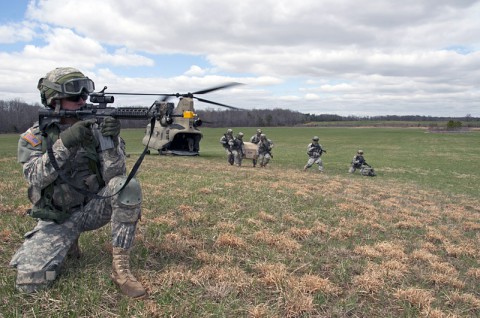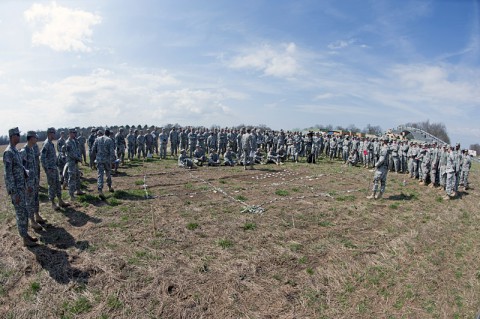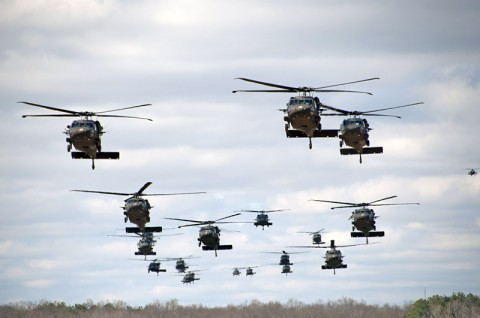Written by Staff Sgt. Joel Salgado
3rd Brigade Combat Team Public Affairs
 Fort Campbell, KY – The 101st Airborne Division (Air Assault) holds a unique position as the only air assault division in the world. As an air assault-focused unit, the division must be ready at a moment’s notice to plan, coordinate, and execute brigade-size air assault operations capable of seizing key terrain in support of operational objectives.
Fort Campbell, KY – The 101st Airborne Division (Air Assault) holds a unique position as the only air assault division in the world. As an air assault-focused unit, the division must be ready at a moment’s notice to plan, coordinate, and execute brigade-size air assault operations capable of seizing key terrain in support of operational objectives.
“The 101st Airborne Division provides the National Command Authority an air assault early entry force capable of working in austere environments with limited or degraded infrastructure,” said Maj. Gen. James C. McConville, commander of the 101st Airborne Division (Air Assault).

The reality is that, like most military operations, it is a complex synchronization of moving elements. Extensive planning is required to organize the aircraft movement, the artillery fires and the logistical challenges of supplying and sustaining more than 1,100 Soldiers and their equipment in a multiple-day, sustained engagement.
“The BCT (brigade combat team) began planning for Operation Golden Eagle three months prior to the execution,” said Maj. David Conner, executive officer for 3rd BCT. “Many of us had never done something on this scale before, and Golden Eagle gave us an appreciation for the enormity of the task.”
Key to the success of these types of missions is the division’s Gold Book that defines the standards and establishes the procedures to plan, execute and quantify the success of an air assault mission.

“The Gold Book is the standard for air assault operations,” said Conner. “We followed it step-by-step and it ensured we considered not only what was required for the air assault plan, but what to do in the event of air assault contingencies.”
To validate the Gold Book, the division recently executed Operation Golden Eagle, its first large-scale air assault training operation in more than a decade.
“Our mission is to provide highly trained, disciplined and fit air assault forces and serve as the only air assault division in the world; capable of discriminate, agile and adaptive operations to engage enemy force or to seize and hold key terrain. Operation Golden Eagle will demonstrate our ability to accomplish that mission,” said McConville. “We provide a unique capability not available anywhere else in the world.”
The 3rd BCT and 101st CAB forces set out to validate their brigade’s ability to plan and execute combined arms maneuver in its current modularized configuration and to establish any shortcoming to reach the intended BCT 2020 structure.
“Recent structural realignments within the division and brigade continue to enhance our combat power with new artillery, engineer, logistics, and infantry units,” said Col. J.B. Vowell, commander of 3rd BCT. “Those systems are all being tested here at Fort Campbell during Operation Golden Eagle.”

The scenario that will put all of the components to the test is similar to the new Full-Spectrum Training Engagements that are used in the Army’s major readiness and training centers that involve brigade-size operations instead of the counterinsurgency focused missions of the past decade.
“As we move from a counterinsurgency operation focused force to a decisive action force capable of providing air assault forces, this exercise gives us the opportunity to conduct the complex training required for conducting complex operations at the brigade level or higher,” McConville said.
In the exercise scenario, the host nation forces are currently engaged in a civil war that has torn the country apart. In addition to destabilizing the region, it provides a hotbed for insurgent activity linked to larger terrorist networks. The U.S. forces will attempt to establish security in the host nation and destroy the insurgent forces.
Initially, the scouts from 1st Squadron, 33rd Cavalry Regiment, in conjunction with scouts from 1st and 3rd Battalion, 187th Infantry Regiment, and utilizing unmanned aerial vehicles from 3rd BCT and OH 58 Kiowa helicopters from 101st CAB, conducted a two-day reconnaissance of the battlefield to provide the unit with a better understanding of the situation at hand.
“Since the BCT reorganization, this unit has never conducted a squadron-wide reconnaissance mission,” said Lt. Col. Jason Curl, commander of 1st Squadron, 33rd Cavalry Regiment. “This is a ground breaking event for us to develop the skills essential to provide reconnaissance in support of a brigade air assault. That is our number one core competency.”
Armed with a detailed knowledge of the battle space, the unit then conducted the first of its air assault raids by delivering six artillery pieces, ammunition and Soldiers at two separate locations. Upon arrival, the artillerymen of 3rd Battalion, 320th Field Artillery Regiment began suppression of enemy forces for follow on air assaults conducted by 1st and 3rd Battalion, 187th Infantry Regiment.
“This operation allowed us to get back to utilizing skills traditional to a field artillery battalion in unified land operations such as acting as the Force Field Artillery HQ, SEAD (Suppression of Enemy Air Defenses), and conducting the close supporting fires and counter-fire,” said Lt. Col. Brendan Raymond, commander of 3rd Battalion, 320th Field Artillery Regiment.
With the enemy air defenses taken out of action, the main effort of the mission began. Through a series of lifts, Soldiers and equipment from the two infantry battalions seized multiple objectives to achieve the key goals of the mission.
The exercise wrapped up on the fourth day with the Soldiers and equipment returning from the training area to their respective unit footprints for an after action review that would focus on areas where the brigade faced challenges during the mission.
“We are educating a generation of Soldiers on the capabilities of the only air assault division in the world,” said Conner. “Golden Eagle taught us many lessons on the intricacies of air assault and how to execute on a large scale. The BCT will apply these lessons in future training events.”
Photo Gallery











